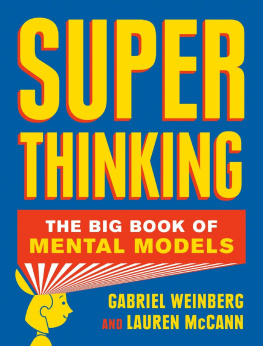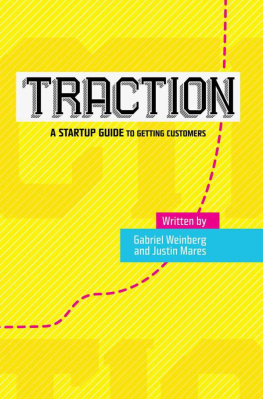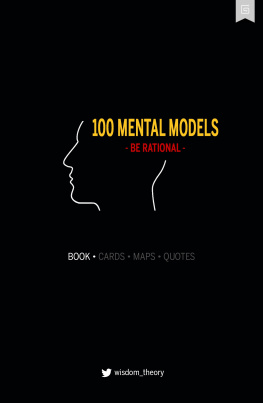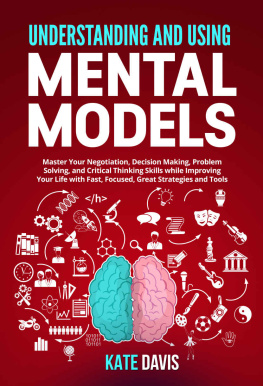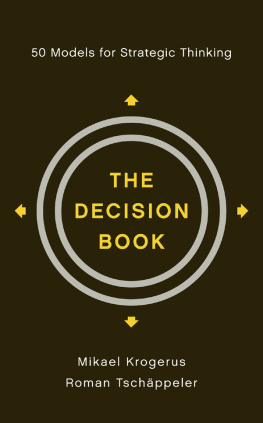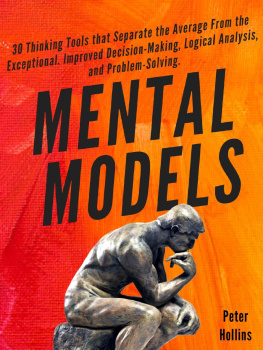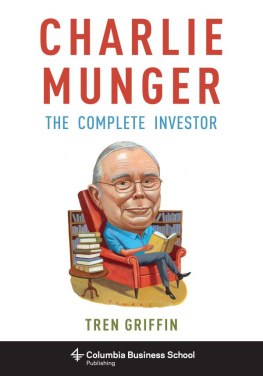

PORTFOLIO / PENGUIN
An imprint of Penguin Random House LLC
penguinrandomhouse.com

Copyright 2019 by Gabriel Weinberg and Lauren McCann
Penguin supports copyright. Copyright fuels creativity, encourages diverse voices, promotes free speech, and creates a vibrant culture. Thank you for buying an authorized edition of this book and for complying with copyright laws by not reproducing, scanning, or distributing any part of it in any form without permission. You are supporting writers and allowing Penguin to continue to publish books for every reader.
Image credits appear on
LIBRARY OF CONGRESS CATALOGING-IN-PUBLICATION DATA
Names: Weinberg, Gabriel, author. | McCann, Lauren, author.
Title: Super Thinking: The Big Book of Mental Models / Gabriel Weinberg and Lauren McCann.
Description: New York: Portfolio/Penguin, [2019] | Includes index.
Identifiers: LCCN 2019002099 (print) | LCCN 2019004235 (ebook) | ISBN 9780525533597 (ebook) | ISBN 9780525542810 (international edition) | ISBN 9780525533580 (hardcover)
Subjects: LCSH: Thought and thinking. | Cognition. | Reasoning.
Classification: LCC BF441 (ebook) | LCC BF441 .W4446 2019 (print) | DDC 153.4/2dc23
LC record available at https://lccn.loc.gov/2019002099
While the authors have made every effort to provide accurate telephone numbers, internet addresses, and other contact information at the time of publication, neither the publisher nor the authors assume any responsibility for errors, or for changes that occur after publication. Further, the publisher does not have any control over and does not assume any responsibility for authors or third-party websites or their content.
Version_2
Contents
Introduction
The Super Thinking Journey
EACH MORNING, AFTER OUR KIDS head off to school or camp, we take a walk and talk about our lives, our careers, and current events. (Were married.) Though we discuss a wide array of topics, we often find common threadsrecurring concepts that help us explain, predict, or approach these seemingly disparate subjects. Examples range from more familiar concepts, such as opportunity cost and inertia, to more obscure ones, such as Goodharts law and regulatory capture. (We will explain these important ideas and many more in the pages that follow.)
These recurring concepts are called mental models . Once you are familiar with them, you can use them to quickly create a mental picture of a situation, which becomes a model that you can later apply in similar situations. (Throughout this book, major mental models appear in boldface when we introduce them to you. We use italics to emphasize words in a models name, as well as to highlight common related concepts and phrases.)
In spite of their usefulness, most of these concepts are not universally taught in school, even at the university level. We picked up some of them in our formal education (both of us have undergraduate and graduate degrees from MIT), but the bulk of them we learned on our own through reading, conversations, and experience.
We wish we had learned about these ideas much earlier, because they not only help us better understand what is going on around us, but also make us more effective decision makers in all areas of our lives. While we cant go back in time and teach our younger selves these ideas, we can provide this guide for others, and for our children. That was our primary motivation for writing this book.
An example of a useful mental model from physics is the concept of critical mass , the mass of nuclear material needed to create a critical state whereby a nuclear chain reaction is possible. Critical mass was an essential mental model in the development of the atomic bomb.
Every discipline, like physics, has its own set of mental models that people in the field learn through coursework, mentorship, and firsthand experience. There is a smaller set of mental models, however, that are useful in general day-to-day decision making, problem solving, and truth seeking. These often originate in specific disciplines (physics, economics, etc.), but have metaphorical value well beyond their originating discipline.
Critical mass is one of these mental models with wider applicability: ideas can attain critical mass; a party can reach critical mass; a product can achieve critical mass. Unlike hundreds of other concepts from physics, critical mass is broadly useful outside the context of physics. (We explore critical mass in more detail in Chapter 4.)
We call these broadly useful mental models super models because applying them regularly gives you a super power: super thinking the ability to think better about the worldwhich you can use to your advantage to make better decisions, both personally and professionally.
We were introduced to the concept of super models many years ago through Charlie Munger, the partner of renowned investor Warren Buffett. As Munger explained in a 1994 speech at University of Southern California Marshall Business School titled A Lesson on Elementary, Worldly Wisdom as It Relates to Investment Management and Business:
What is elementary, worldly wisdom? Well, the first rule is that you cant really know anything if you just remember isolated facts and try and bang em back. If the facts dont hang together on a latticework of theory, you dont have them in a usable form. Youve got to have models in your head. And youve got to array your experienceboth vicarious and directon this latticework of models.
As the saying goes, History doesnt repeat itself, but it does rhyme. If you can identify a mental model that applies to the situation in front of you, then you immediately know a lot about it. For example, suppose you are thinking about a company that involves people renting out their expensive power tools, which usually sit dormant in their garages. If you realize that the concept of critical mass applies to this business, then you know that there is some threshold that needs to be reached before it could be viable. In this case, you need enough tools available for rent in a community to satisfy initial customer demand, much as you need enough Lyft drivers in a city for people to begin relying on the service.
That is super thinking, because once you have determined that this business model can be partially explained through the lens of critical mass, you can start to reason about it at a higher level, asking and answering questions like these: What density of tools is needed to reach the critical mass point in a given area? How far away can two tools be to count toward the same critical mass point in that area? Is the critical mass likely to be reached in an area? Why or why not? Can you tweak the business model so that this critical mass point is reachable or easier to reach? (For instance, the company could seed each area with its own tools.)
As you can see, super models are shortcuts to higher-level thinking. If you can understand the relevant models for a situation, then you can bypass lower-level thinking and immediately jump to higher-level thinking. In contrast, people who dont know these models will likely never reach this higher level, and certainly not quickly.
Think back to when you first learned multiplication. As you may recall, multiplication is just repeated addition. In fact, all mathematical operations based on arithmetic can be reduced to just addition: subtraction is just adding a negative number, division is just repeated subtraction, and so on. However, using addition for complex operations can be really slow, which is why you use multiplication in the first place.
Next page
